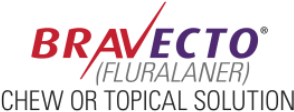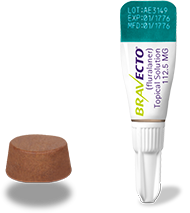IMPORTANT SAFETY INFORMATION:
BRAVECTO has not been shown to be effective for 12-weeks’ duration in puppies or kittens less than 6 months of age. Fluralaner is a member of the isoxazoline class. This class has been associated with neurologic adverse reactions including tremors, ataxia, and seizures. BRAVECTO Chew: The most commonly reported adverse reactions include vomiting, decreased appetite, diarrhea, lethargy, polydipsia, and flatulence. BRAVECTO is not effective against lone star ticks beyond 8 weeks of dosing. Seizures have been reported in dogs receiving isoxoline class drugs, even in dogs without a history of seizures. Use with caution in dogs with a history of seizures or neurologic disorders. BRAVECTO Topical Solution for Dogs: The most commonly reported adverse reactions include vomiting, hair loss, diarrhea, lethargy, decreased appetite, and moist dermatitis/rash. Bravecto is not effective against lone star ticks beyond 8 weeks of dosing. For topical use only. Avoid oral ingestion. Seizures have been reported in dogs receiving isoxoline class drugs, even in dogs without a history of seizures. Use caution in dogs with a history of seizures or neurologic disorders. BRAVECTO Topical Solution for Cats: The most commonly reported adverse reactions include vomiting, itching, diarrhea, hair loss, decreased appetite, lethargy, and scabs/ulcerated lesions. BRAVECTO is not effective against American dog ticks beyond 8 weeks of dosing. For topical use only. Avoid oral ingestion. The safety of BRAVECTO has not been established in breeding, pregnant and lactating cats. Neurologic adverse reactions have been reported in cats receiving isoxazoline class drugs, even in cats without a history of neurologic disorders. Use with caution in cats with a history of neurologic disorders.
References:
1. Bravecto Chew for Dogs [prescribing information]. Madison, NJ: Merck Animal Health; 2014.
2. Bravecto Topical Solution for Dogs [prescribing information]. Madison, NJ: Merck Animal Health; 2016.
3. Bravecto Topical Solution for Cats [prescribing information]. Madison, NJ: Merck Animal Health; 2016.
4. Rohdich N, Roepke RKA, Zschiesche E. A randomized, blinded, controlled and multi-centered field study comparing the efficacy and safety of Bravecto™ (fluralaner) against Frontline™ (fipronil) in flea- and tick-infested dogs. Parasites & Vectors. 2014;7:83.
5. Beck S, Schein E, Baldermann C, von Samson-Himmelstjerna G, Kohn B. Tick infestation and tick prophylaxis in dogs in the area of Berlin/Brandenburg – results of a questionnaire study. Berl Munch Tierarztl Wochenschr. 2013;126(1-2):69-76.
6. Kidd L, Breitschwerdt EB. Transmission times and prevention of tick-borne diseases in dogs. Compend Contin Educ Pract Vet. 2003;(25)10:742-751.
7. Freedom of Information Summary, NADA 141-426. Approved May 15, 2014.
8. Freedom of Information Summary, NADA 141-459. Approved 2016.
9. Gassel M, Wolf C, Noack S, Williams H, Ilg T. The novel isoxazoline ectoparasiticide fluralaner: selective inhibition of arthropod γ-aminobutyric acid- and L-glutamate-gated chloride channels and insecticidal/acaricidal activity. Insect Biochem Mol Biol. 2014;45:111-124.
10. Williams H, Demeler J, Taenzler J, Roepke RK, Zshiesche E, Heckeroth AR. A quantitative evaluation of the extent of fluralaner uptake by ticks (Ixodes ricinus, Ixodes scapularis) in fluralaner (Bravecto™) treated vs. untreated dogs using the parameters tick weight and coxal index. Parasites & Vectors. 2015;8:352.
11. Taenzler J, Wengenmayer C, Williams H, et al. Onset of activity of fluralaner (Bravecto™) against Ctenocephalides felis on dogs. Parasites & Vectors. 2014;7:567.
12. Meadows C, Guerino F, Sun F. A randomized, blinded, controlled USA field study to assess the use of fluralaner tablets in controlling flea infestations. Parasites & Vectors. 2014;7:375.
13. CAPCvet.org. Accessed July 5, 2016.
14. Data on File, Merck Animal Health.
15. Taenzler J, Liebenberg J, Roepke RKA, Heckeroth AR. Prevention of transmission of Babesia canis by Dermacentor reticulatus ticks to dogs treated orally with fluralaner chewable tablets (Bravecto™). Parasites & Vectors. 2015;8:305.
16. Wengenmayer C, Williams H, Zschiesche E, et al. The speed of kill of fluralaner (Bravecto™) against lxodes ricinus ticks on dogs. Parasites & Vectors. 2014;7:525.
17. Walther FM, Allan MJ, Roepke RKA, Nuernberger MC. Safety of fluralaner chewable tablets (Bravecto™), a novel systemic antiparasitic drug, in dogs after oral administration. Parasites & Vectors. 2014;7:87.
18. Walther FM, Allan MJ, Roepke RKA, Nuernberger MC. Safety of fluralaner, a novel systemic antiparasitic drug, in MDR1(-/-) collies after oral administration. Parasites & Vectors. 2014;7:86.
19. Burgio et al. Parasites & Vectors (2016) 9:626.
20. Meadows et al, Parasites & Vectors, (2017) 10:36.
21. Meadows et al, Parasites & Vectors, (2017) 10:37.





